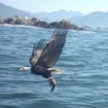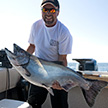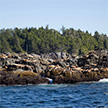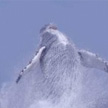What came first? The salmon or the egg?
Which came first, the Salmon or the Egg?
By James Costello
 In order for hatcheries to have eggs to raise, they need to catch the adult salmon first. These fish are called brood stock, and they are collected in a number of different ways depending on the type of hatchery they will be used in. All brood stock needs to be collected when the fish return to freshwater for a few reasons, but most importantly – they have to be ready to spawn, or ripe. A fish that isn’t ready to spawn is called green (although sometimes they can be silver, or red, or black!) and it hasn’t gone through the process of maturation yet. Some salmon can live up to 8 years in the ocean, but most come back between 2 and 4 years after they leave the river they were born in. Chinook salmon, which are a very popular target for fisherman because of their size and fight, can return at 3 years as about a 12-15lb fish, or stay out as long as 6 or more years and be over 100lbs!
In order for hatcheries to have eggs to raise, they need to catch the adult salmon first. These fish are called brood stock, and they are collected in a number of different ways depending on the type of hatchery they will be used in. All brood stock needs to be collected when the fish return to freshwater for a few reasons, but most importantly – they have to be ready to spawn, or ripe. A fish that isn’t ready to spawn is called green (although sometimes they can be silver, or red, or black!) and it hasn’t gone through the process of maturation yet. Some salmon can live up to 8 years in the ocean, but most come back between 2 and 4 years after they leave the river they were born in. Chinook salmon, which are a very popular target for fisherman because of their size and fight, can return at 3 years as about a 12-15lb fish, or stay out as long as 6 or more years and be over 100lbs! When adult Pacific salmon start to get ready to spawn, they undergo huge changes both inside and outside their body. Inside their body they will be putting all the energy they get from food into their reproductive organs – egg skeins in the females, and gonads in the males. Because this is their most important mission EVER (it is a one-way trip), they will even start to take energy from non-essential organs – and even including things like their scales! From the outside you will see a change in colour, from a silvery ocean fish, they will start to turn a combination of colours, sometimes with very distinct patterns. Earlier I specifically mentioned “Pacific” salmon because other types of salmonids may not all die after spawning – for example, Atlantic salmon and Steelhead (an ocean-going Rainbow trout) can spawn multiple times in their lifetime, which can be up to 8 years. The different types of Pacific salmon are Chinook, Coho, Chum, Sockeye, and Pink. At the Thornton Creek Hatchery where I work part time, we raise 3 of the most commonly cultured species - Chinook, Coho, and Chum salmon.
Now that we’ve figured out what we’re after and what they are doing there, let’s look at how hatcheries actually collect the fish they need. In a big facility built on a larger river there might be a series of fences, or weirs, that direct fish coming up the river into concrete raceways which will hold the fish until they can be scooped out using long-handled nets called dipnets. For smaller hatcheries that use pipes to bring the water they need in from another water source, they have to carry the fish from the river into the raceways or holding tanks they use on site. In order to catch the fish they need they might use dipnets to scoop fish right out of the river, or they might use a seine or gill net that stretches all the way across the river: This is where things get heavy, and when lots of volunteers are really helpful!
 A seine net or gillnet used by hatchery workers is very similar to the type that would be used by commercial fisherman in the ocean. A seine net is made of nylon mesh that looks much like the landing net you might use to get your salmon into the boat, but it can be 100ft long and more than 20ft deep with weights along the bottom, called a lead-line. Because of the weight, these nets are usually made in sections that are zipped together once they have been carried into the spots they will be used. These panels can weigh 50lbs each – and a lot more when they are wet!
A seine net or gillnet used by hatchery workers is very similar to the type that would be used by commercial fisherman in the ocean. A seine net is made of nylon mesh that looks much like the landing net you might use to get your salmon into the boat, but it can be 100ft long and more than 20ft deep with weights along the bottom, called a lead-line. Because of the weight, these nets are usually made in sections that are zipped together once they have been carried into the spots they will be used. These panels can weigh 50lbs each – and a lot more when they are wet! A seine net works by surrounding the fish in the river using ropes on either end, then, once the team has brought both the ends together from each side of the river, the bottom is pulled into shore – all the fish are trapped and can then be removed by hand. A gillnet is made of the same monofilament line that you would use for fishing and is woven into squares big enough for the fish to get its head through. It works by tangling the fish up – you guessed it – by their gills. These can be used only when just the type of fish you want to catch is in the river, because it is very hard to release fish from a gillnet once they have tangled themselves up trying to get away.
In many cases all this activity will be happening far from the hatchery itself, as quite a few facilities will collect their brood stock from a few different rivers in the area they are located. The logistics of moving all the gear and people to the places they are needed can take up a big part of the resources available, and volunteers and donations make much of the work possible.
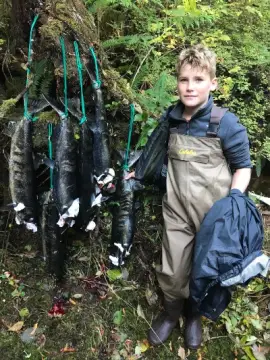 After all the effort has been put into catching the salmon that contain the eggs and milt needed to make the next generation possible, the next phase can begin – this is where the ripe adult fish are quicky served with a bonk on the head in order to ensure they are humanely euthanized. Only the fish that are ready to spawn are used, and each fish has to be gently squeezed to see whether they have loose eggs or milt being expressed. After the fish have been dispatched, they are hung by the tail and have their gills cut so they will bleed out and can be dried and cleaned with paper towel, so no blood or slime gets in the eggs or milt that are collected.
After all the effort has been put into catching the salmon that contain the eggs and milt needed to make the next generation possible, the next phase can begin – this is where the ripe adult fish are quicky served with a bonk on the head in order to ensure they are humanely euthanized. Only the fish that are ready to spawn are used, and each fish has to be gently squeezed to see whether they have loose eggs or milt being expressed. After the fish have been dispatched, they are hung by the tail and have their gills cut so they will bleed out and can be dried and cleaned with paper towel, so no blood or slime gets in the eggs or milt that are collected. The female fish are cut open with a clean and sharp knife so that the eggs can spill out into collection bowl – a big, stainless steel mixing bowl seems to be the style that works best. Male fish are held with their head up and squeezed along their belly towards their tail, this pushes the milt out in a stream that can be collected in a small bag – all the while being kept out of the sunlight, as the UV rays can damage the milt and make it infertile. Both eggs and milt must be kept out of the sunlight and at a temperature which closely matches the source river and the destination while in transport – sometimes it can take a few hours or more to get back to the hatchery where the next steps take place.
Next time we will look at how eggs are fertilized and how a hatchery works!
